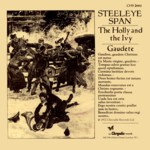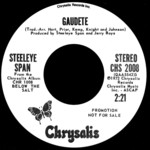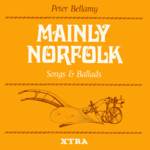> Steeleye Span > Songs > Gaudete
Gaudete
 |
Gaudete /
The Holly and the Ivy Chrysalis CHS 2007 (single, p/s, UK, December 1972) Gaudete (stereo) / Gaudete (mono) Chrysalis CHS 2008 (promotion single, UK, 1972) |
 |
[ Roud - ; DT GAUDET ; Mudcat 5096 , 141825 ; trad., from Piæ Cantiones (Finland, 1582)]
Inspired by Bob Johnson who heard it in his father-in law’s church, Steeleye Span first sang Gaudete in 1972 on their fourth album Below the Salt. The album’s sleeve notes set the mood with::
Mist takes the morning path to wreath the willows—Rejoice, rejoice—small birds sing as the early rising monk takes to his sandals—Christ is born of the Virgin Mary—cloistered, the Benedictine dawn threads timelessly the needles eye—rejoice.
In December 1972, a different edit of Gaudete, without the Cathedral-like acoustics, was issued as a Steeleye Span single with the B-side The Holly and the Ivy. It was re-released in November 1973 to reach chart #14 as Steeleye’s first outstanding chart success. The track was also used in 1977 for the B-side of their single The Boar’s Head Carol. The song has appeared on many compilations over the years but with the exception of the Original Masters 2 CD set, the single version seems to have become lost in favour of the album version. An original tape copy was found in the Festival Records tape vaults and has been fully sound restored for reissue on the 1999 CD A Rare Collection 1972-1996.
At least nine live recordings of Gaudete with several Steeleye Span line-ups were released:
- from a BBC Radio John Peel Session recorded on 2 October 1972, on the 1987 BBC compilation Through Bushes and Briar,
- from the “Sound of Britain” concert at the Jahrhunderthalle in Frankfurt, Germany, on 17 January 1973, recorded by Hessischer Rundfunk, on the 2003 compilation The Harvest of Gold,
- at The Bottom Line, New York on 4 July 1974, on the 2024 CD Live at the Bottom Line, 1974,
- at the Royal Opera Theatre in Adelaide, Australia in 1982 on the Australia-only LP On Tour and on the CD Gone to Australia,
- at the Beck Theatre, Hayes, Middlesex on 16 September 1989 on the video A 20th Anniversary Celebration,
- from 1994, probably May 1994 in Australia, on the CD Steeleye Span in Concert,
- at at The Forum, London on 2 Septemebr 1995 on the 1999 double CD The Journey,
- at the Southampton Guildhall, 15 May 2004 on the DVD The 35th Anniversary World Tour 2004 and double CD Folk Rock Pioneers in Concert,
- from their spring tour 2011 on the bonus CD of their 2011 album Now We Are Six Again,
- and a Swiss TV video from 1974:
A new recording of Gaudete was released as a CD single in 2001 by Keltic Fusion (i.e. Troy Donockley, Nick Holland, Rose Kemp, Jacqui McShee, and Maddy Prior). I don’t like this version very much; electronic drum ’n’ bass doesn’t really fit with this lovely song.
Steeleye Span recorded Gaudete again for the CD Present to accompany their December 2002 reunion tour.
The York Waits sang Gaudete, Christus est natus in 1992 on their Saydisc album Old Christmas Return’d.
Ougenweide sang Gaudete on their 1996 album Sol.
GreenMatthews sang Gaudete on their 2012 CD A Medieval Christmas.
Anna Shannon sang Gaudete in 2014 on her WildGoose album A Celebration of Old England. She noted:
How could l have recorded this album without including my favourite of all time! This 15th century piece never fails to stir a great sense of excitement in me!
Doug Eunson and Sarah Matthews sang Gaudete on their 2019 CD Chimes. They noted:
This ancient hymn has its origins in the sixteenth century with Latin text.
Lyrics
Steeleye Span sing Gaudete
Gaudete, gaudete! Christus est natus
Ex Maria virgine, gaudete!
Tempus adest gratiæ,
Hoc quod optabamus
Carmina lætitiæ
Devote redamus.
Deus homo factus est
Natura mirante,
Mundus renovatus est
A Christo regnante.
Ezechielis porta
Clausa pertransitur
Unde Lux est orta
Salus invenitur.
Ergo nostra contio
Psallat iam in lustro,
Benedicat Domino
Salus Regi nostro.
Translation
Rejoice! Rejoice! Christ is born
Of the Virgin Mary, rejoice!
The time of grace has come
For which we have prayed
Let us devoutly sing
Songs of joy.
God is made man,
While nature wonders
The world is renewed
By Christ the King.
The closed gate of Ezekiel
Has been passed through
From where the light has risen [the East],
Salvation is found.
Therefore let our assembly sing praises now
At this time of purification
Let it bless the Lord:
Greetings to our King.
(from the New Oxford Book of Carols, 1992)
Notes
From The Shorter New Oxford Book of Carols:
No music is given for the verses in Piæ Cantiones. They derive from the medieval Bohemian song Ezechielis Porta, which Finnish clerical students would have encountered in Prague and which shared a tune with a Czech vernacular Christmas song that still survives. Finno, the editor of Piæ Cantiones, was probably responsible for the refrain. It adapts the words of one of the medieval verses to the music which, in various forms, was sung throughout Lutheran Germany to Luther’s single-stanza grace before meals, Danket dem Herrn. Verse 3 refers to the eastern gate of the city in Ezekiel’s vision (Ezekiel 44:2). The gate is a traditional symbol of Mary as perpetual virgin.
Alternative lyrics
The Kipper Family sing Awayday
From The Kipper Family: Arrest These Merry Gentlemen (Dambuster DAM 022, 1989)
Chorus (twice after each verse):
Away day, away day, loco in transit
Omnibus, St Pancreas, away day
Cleopatra virginae, terra incognito
In loc parentis caesar mutlio calcutta
Troyalus et Cressida, con Homo erectus
Strangulated hernia, coitus interruptus
Romulus et Remus, in flagrante delicto
Honi soit qui mal y pense, Harry Belafontee
Gina Lollobrigida, Osteo Arthritis
In vino veritas, Peter Dominicus
Non compos mentis, continuo ad nauseam
Ad lib, et cetera, quod erat demonstrandum
Fairport Convention sing Crudités
Lyrics by Pat Goodacre, Jessica Abraham, Blanche Rowen, Mike Gulston; melody trad. 15th century
Crudités, crudités with crisps for starters
Anchovies in virgin oil, crudités
Guacamole, caviare, basil and tomata
Aubergine and feta dip, taramasalata
Gorgonzola, Camembert, tapenade and nachos
Button mushrooms à la greque, croutons in gazpacho
Tiramisu, creme brulée, chocolate that melts-a
Cheesecake and profiterôles—pass the Alka Seltzer!
Acknowledgements
Thanks to Joe Offer for correcting the errors in the verses on the record sleeve and for supplying the translation and notes.

